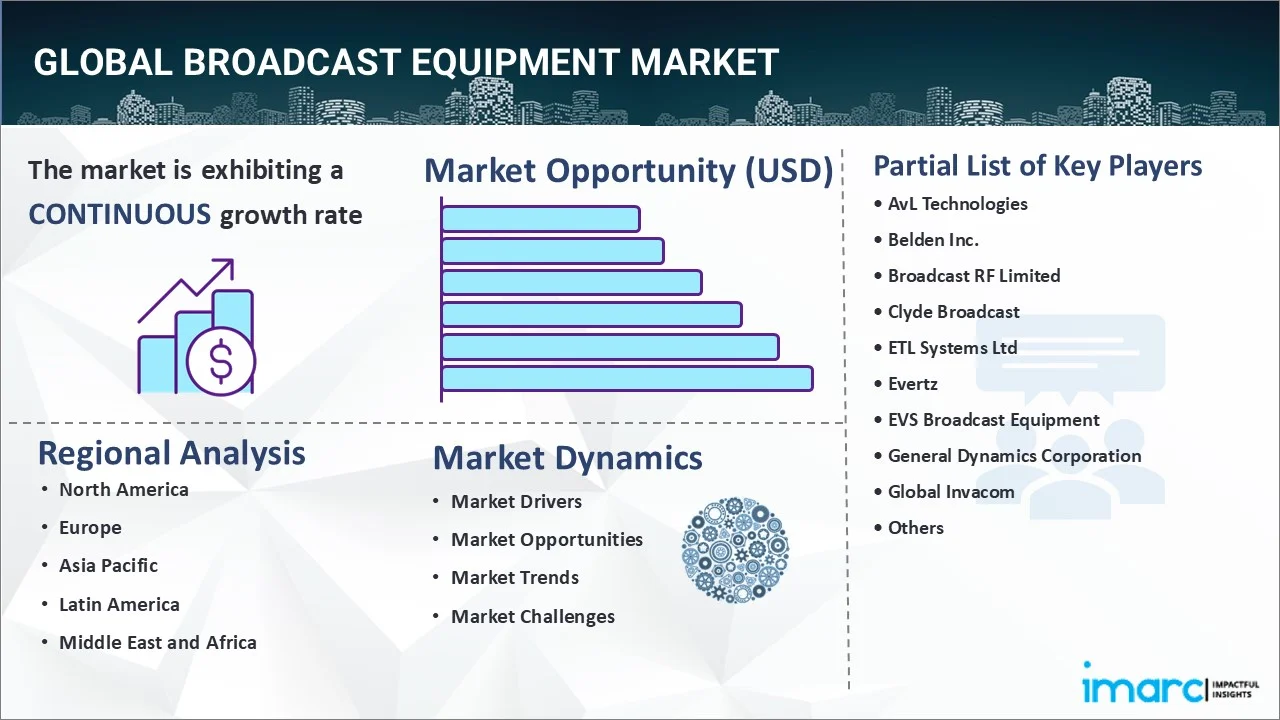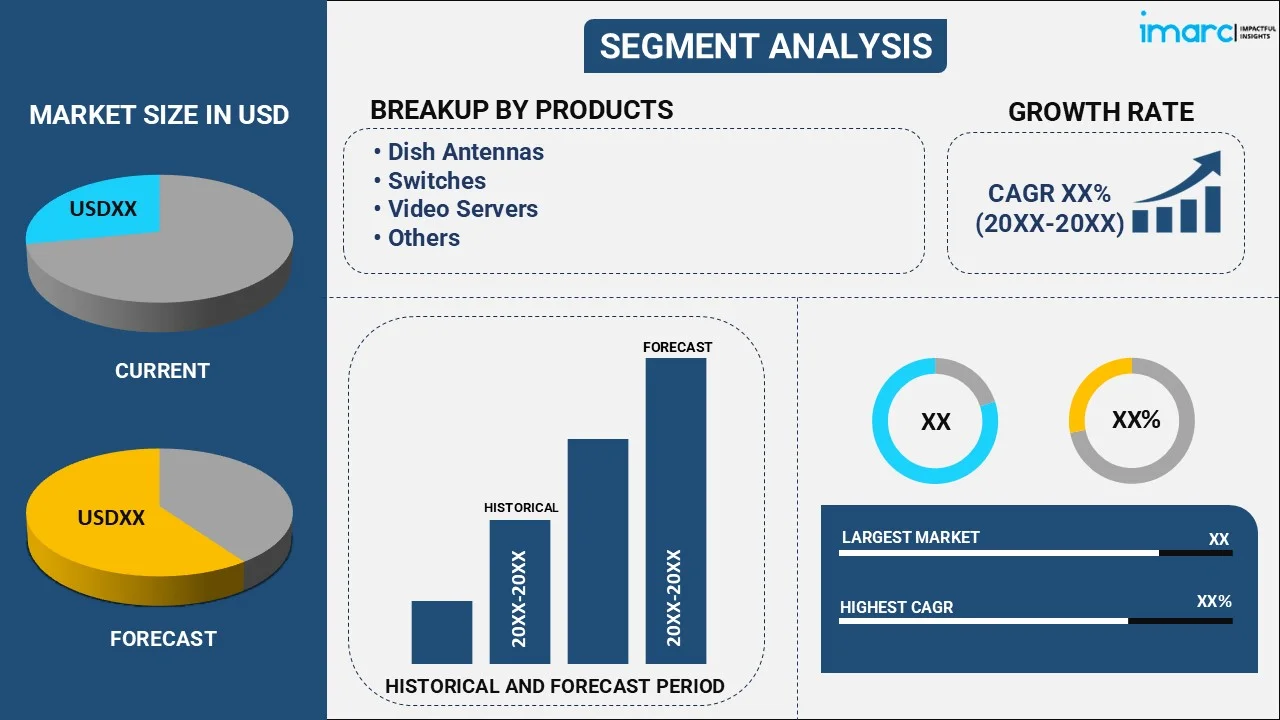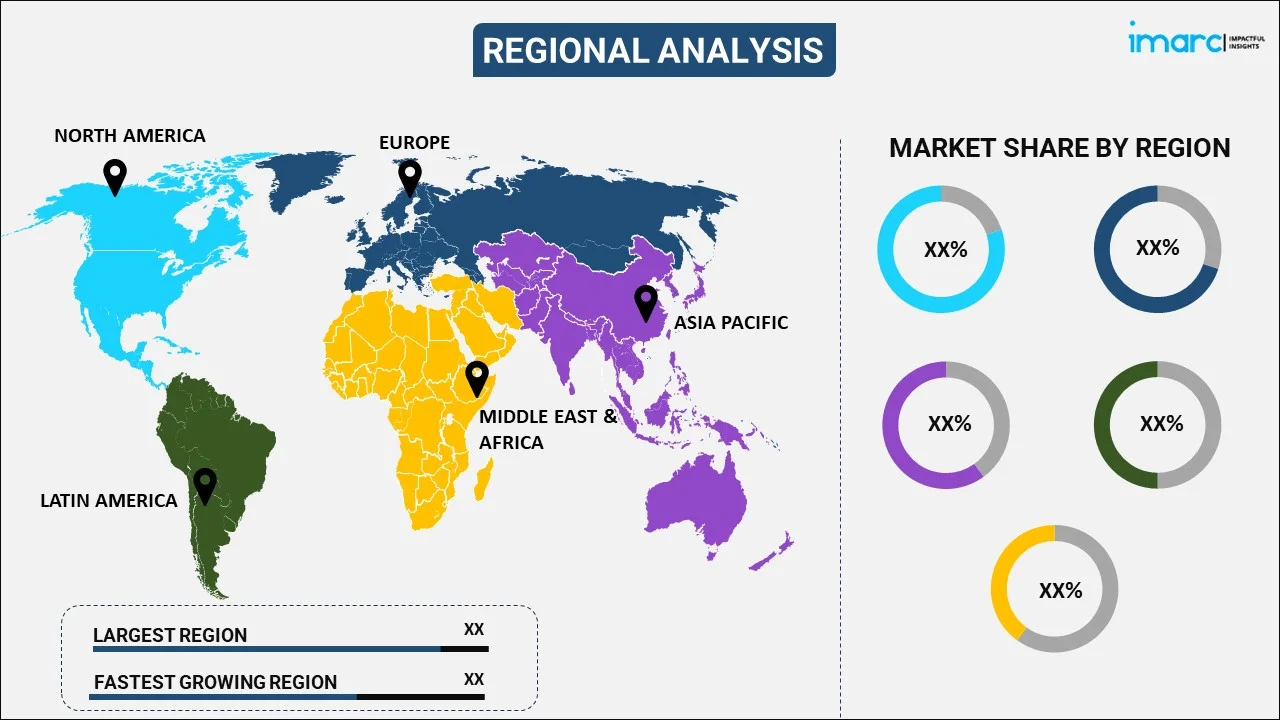
Broadcast Equipment Market Report by Product (Dish Antennas, Switches, Video Servers, Encoders, Transmitters and Repeaters, and Others), Technology (Analog Broadcasting, Digital Broadcasting), Application (Studio Production, Post Production, Sports Production, News Production), and Region 2025-2033
Global Broadcast Equipment Market:
The global broadcast equipment market size reached USD 5.6 Billion in 2024. Looking forward, the market is expected to reach USD 8.1 Billion by 2033, exhibiting a growth rate (CAGR) of 4.1% during 2025-2033. The growing popularity of digital content, along with the increasing number of over-the-top (OTT) subscriptions, is primarily propelling the market.
|
Report Attribute
|
Key Statistics
|
|---|---|
|
Base Year
|
2024
|
|
Forecast Years
|
2025-2033
|
|
Historical Years
|
2019-2024
|
|
Market Size in 2024
|
USD 5.6 Billion |
|
Market Forecast in 2033
|
USD 8.1 Billion |
| Market Growth Rate (2025-2033) | 4.1% |
Broadcast Equipment Market Analysis:
- Major Market Drivers: The increasing consumer inclination towards better viewing quality is one of the key factors bolstering the market. Additionally, continuous improvements in cloud infrastructures are also acting as significant growth-inducing factors.
- Key Market Trends: Key players are focusing on replacing conventional SDI-based environments with live production systems that offer high efficiency and system control, which is positively influencing the market. Apart from this, numerous advancements related to the Internet of Things (IoT) are further stimulating the global market.
- Competitive Landscape: Some of the prominent companies in the global market include AvL Technologies, Belden Inc., Broadcast RF Limited, Clyde Broadcast, ETL Systems Ltd, Evertz, EVS Broadcast Equipment, General Dynamics Corporation, Global Invacom, Grass Valley, Sencore (Wellav Technologies Ltd.), and Telefonaktiebolaget LM Ericsson, among many others.
- Geographical Trends: North America exhibits a clear dominance in the market, owing to the inflating trend towards live streaming. Furthermore, the rise of satellite broadcasting is also catalyzing the market across the region.
- Challenges and Opportunities: One of the primary challenges hindering the market is the high cost of broadcasting technologies. However, extensive investments in R&D activities to develop flexible financing options for broadcasters are anticipated to fuel the market in the coming years.

Broadcast Equipment Market Trends:
Shift Towards IP-based Broadcasting
The increasing demand for alternatives to traditional broadcast infrastructure represents one of the drivers propelling the market. IP-based systems allow broadcasters to reduce latency, enhance content delivery, streamline operations, etc., across various platforms. In June 2024, the Namibian Broadcasting Corporation (NBC) based in South Africa improved its audio infrastructure with the installation of Lawo's state-of-the-art IP-based equipment, including diamond consoles and power cores, thereby elevating its broadcasting capabilities with cutting-edge solutions. Additionally, in May 2024, SES showcased an on-air demo leveraging the new DVB-NIP (Native IP) and DVB-I standards that are set to change content delivery via satellite. Besides this, the growing requirement for more scalable, flexible, and cost-effective solutions is also stimulating the market. For instance, in January 2024, TVU Networks, one of the companies specializing in cloud and IP-based live video technologies, unveiled its latest cloud-based broadcast solution called TVU MediaHub. The platform has main features, such as hybrid and unlimited scalability, versatile input/output capability, a user-friendly interface, etc. The transition to IP technology has allowed broadcasters like ESPN to efficiently manage live sports broadcasts by integrating several feeds and delivering high-quality content seamlessly across TV and digital platforms.
Demand for UHD Content
The widespread popularity of superior video quality is encouraging broadcasters towards 4K and 8K ultra-high-definition (UHD) content. Consumers increasingly prefer high-definition viewing experiences. Consequently, prominent players are investing in advanced cameras, encoders, and other UHD equipment. For example, in October 2023, reinforcing its commitment to the broadcasting and video production segment, Canon India, one of the leading digital imaging solution companies, developed its innovative range of remote PTZ (pan-tilt-zoom) cameras at the 32nd Broadcast India Show that was held at the Jio World Convention Centre, Mumbai. Furthermore, in April 2024, Aven, a full-service technology provider, unveiled the Cyclops 4K ultra-HD digital microscope. It offers users an immersive viewing experience with 4K resolution, thereby delivering unprecedented clarity and detail. Equipped with advanced optics and high-resolution imaging technology, the Cyclops provides magnification levels ranging from 13x to 140x. Apart from this, the increasing number of virtual events and hybrid gatherings is also contributing to the market. For instance, in June 2024, Speedy Event Rentals expanded their services to include video and audio broadcast equipment rentals in New York City, U.S., that offer customers with a one-stop-shop for all their event needs.
Rise of Streaming Services
The increasing proliferation of OTT services is strengthening the market. As per the IMARC, the global over-the-top (OTT) market size reached US$ 461.0 Billion in 2023. Looking forward, IMARC Group expects the market to reach US$ 3,400.0 Billion by 2032, exhibiting a growth rate (CAGR) of 24.1% during 2024-2032. Moreover, prominent players like Amazon Prime, Netflix, and Disney+ have revolutionized how content is consumed, thereby bolstering the requirement for broadcast equipment that can support seamless streaming. Besides this, the launch of policies related to OTT platforms is also positively influencing the market. For instance, in April 2024, the Telecom Regulatory Authority of India (TRAI) seeked inputs on the National Broadcasting Policy to improve TV access in households and boost local manufacturing of broadcast equipment. Similarly, in April 2024, one of the direct-to-home (DTH) providers, Dish TV, introduced Dish TV Smart+ to provide customers access to both TV and over-the-top (OTT) content. Besides this, the growing popularity of live-streaming events is projected to fuel the market in the coming years. For example, in June 2024, Vislink Technologies, Inc., a global technology leader in the delivery, capture, and management of high-quality live video and associated data in the media and entertainment industry, unveiled its INCAM-GV RF and 5G wireless transmitters that mark a pivotal advancement in live production technology, thereby offering broadcasters unparalleled flexibility and image quality.
Global Broadcast Equipment Industry Segmentation:
IMARC Group provides an analysis of the key trends in each segment of the market, along with the broadcast equipment market forecast at the global, regional, and country levels for 2025-2033. Our report has categorized the market based on the product, technology, and application.
Breakup by Product:

- Dish Antennas
- Switches
- Video Servers
- Encoders
- Transmitters and Repeaters
- Others
Encoders currently hold the majority of the total market share
The report has provided a detailed breakup and analysis of the market based on the product. This includes dish antennas, switches, video servers, encoders, transmitters and repeaters, and others. According to the report, encoders represented the largest market segmentation.
Encoders represent the largest segment in the market due to their crucial role in the transmission of high-quality video and audio signals over various platforms, from traditional TV broadcasting to internet streaming services. They convert raw video and audio data into compressed digital formats, enabling efficient storage and transmission without compromising quality. The growing demand for high-definition (HD) and ultra-high-definition (UHD) content, coupled with the proliferation of over-the-top (OTT) services, has further amplified the need for advanced encoding solutions. Recent product launches underscore this trend; for instance, Harmonic's VOS 360 Live Streaming Platform offers cloud-based encoding, significantly enhancing scalability and flexibility for broadcasters. Similarly, AWS Elemental MediaLive provides real-time video encoding with high efficiency, catering to the needs of live event streaming. These innovations demonstrate the critical importance of encoders in meeting the evolving requirements of modern broadcasting, driving their dominance in the market.
Breakup by Technology:
- Analog Broadcasting
- Digital Broadcasting
Digital broadcasting accounts for the largest market share
The report has provided a detailed breakup and analysis of the market based on the technology. This includes analog broadcasting and digital broadcasting. According to the report, digital broadcasting represented the largest market segmentation.
Digital broadcasting is gaining traction, as it offers superior quality, efficiency, and versatility in content delivery. Unlike analog broadcasting, which transmits continuous signals, it converts audio and video into digital data, resulting in clearer sound and picture quality. This technology enables broadcasters to offer multiple channels of programming simultaneously, known as multiplexing, and to incorporate interactive services. A notable example is the transition to digital terrestrial television (DTT) in the UK, which has replaced analog services with Freeview, providing viewers with a wide range of channels and high-definition options without the need for a satellite dish or cable subscription. Similarly, in the United States, the Federal Communications Commission (FCC) mandated the switch to digital television (DTV), enhancing broadcast quality and freeing up bandwidth for other communication services.
Breakup by Application:
- Studio Production
- Post Production
- Sports Production
- News Production
The report has provided a detailed breakup and analysis of the market based on the application. This includes studio production, post production, sports production, and news production.
In studio production, the focus is on high-quality cameras, switchers, and audio equipment essential for creating professional-grade content in controlled environments. Post-production, involving activities, such as editing, color correction, and special effects, relies heavily on advanced software and hardware to enhance and finalize content before distribution. Sports production demands specialized equipment like high-speed cameras, instant replay systems, and robust transmission gear to capture and broadcast dynamic, fast-paced events with clarity and precision. On the other hand, news production prioritizes mobile and versatile equipment, including field cameras, portable editing systems, and satellite uplinks, to deliver timely and accurate reporting from various locations.
Breakup by Region:

- North America
- United States
- Canada
- Asia-Pacific
- China
- Japan
- India
- South Korea
- Australia
- Indonesia
- Others
- Europe
- Germany
- France
- United Kingdom
- Italy
- Spain
- Russia
- Others
- Latin America
- Brazil
- Mexico
- Others
- Middle East and Africa
North America exhibits a clear dominance in the market
The market research report has also provided a comprehensive analysis of all the major regional markets, which include North America (the United States and Canada); Asia Pacific (China, Japan, India, South Korea, Australia, Indonesia, and others); Europe (Germany, France, the United Kingdom, Italy, Spain, Russia, and others); Latin America (Brazil, Mexico, and others); and the Middle East and Africa. According to the report, North America accounted for the largest market share.
As per the broadcast equipment market overview, technological advancements and the increasing demand for UHD content are acting as significant growth-inducing factors. In April 2024, VITAC, one of the U.S.-based captioning companies, and ENCO, a provider of broadcasting solutions, announced a strategic partnership aimed at providing broadcasters with expanded choice for hardware encoders and cloud captioning. Moreover, Grass Valley's LiveTouch system provides advanced replay and highlight capabilities essential for live sports broadcasting, enhancing viewer experience with real-time, high-definition content. Similarly, Harmonic's VOS®360 platform offers cloud-based media processing and delivery solutions, allowing broadcasters to scale operations efficiently and deliver content seamlessly across traditional and OTT channels. These innovations and trends will continue to stimulate the regional market in the coming years.
Competitive Landscape:
The market research report has provided a comprehensive analysis of the competitive landscape. Detailed profiles of all major market companies have also been provided. Some of the key players in the market include:
- AvL Technologies
- Belden Inc.
- Broadcast RF Limited
- Clyde Broadcast
- ETL Systems Ltd
- Evertz
- EVS Broadcast Equipment
- General Dynamics Corporation
- Global Invacom
- Grass Valley
- Sencore (Wellav Technologies Ltd.)
- Telefonaktiebolaget LM Ericsson
(Please note that this is only a partial list of the key players, and the complete list is provided in the report.)
Broadcast Equipment Market Recent Developments:
- June 2024: Vislink Technologies, Inc. introduced its INCAM-GV RF and 5G wireless transmitters that mark a pivotal advancement in live production technology.
- June 2024: Speedy Event Rentals expanded their services to include video and audio broadcast equipment rentals in New York City, U.S., that offer customers with a one-stop-shop for all their event needs.
- April 2024: One of the direct-to-home (DTH) providers, Dish TV, launched Dish TV Smart+ to provide customers access to over-the-top (OTT) content.
Broadcast Equipment Market Report Scope:
| Report Features | Details |
|---|---|
| Base Year of the Analysis | 2024 |
| Historical Period | 2019-2024 |
| Forecast Period | 2025-2033 |
| Units | Billion USD |
| Scope of the Report | Exploration of Historical Trends and Market Outlook, Industry Catalysts and Challenges, Segment-Wise Historical and Predictive Market Assessment:
|
| Products Covered | Dish Antennas, Switches, Video Servers, Encoders, Transmitters and Repeaters, Others |
| Technologies Covered | Analog Broadcasting, Digital Broadcasting |
| Applications Covered | Studio Production, Post Production, Sports Production, News Production |
| Regions Covered | Asia Pacific, Europe, North America, Latin America, Middle East and Africa |
| Countries Covered | United States, Canada, Germany, France, United Kingdom, Italy, Spain, Russia, China, Japan, India, South Korea, Australia, Indonesia, Brazil, Mexico |
| Companies Covered | AvL Technologies, Belden Inc., Broadcast RF Limited, Clyde Broadcast, ETL Systems Ltd, Evertz, EVS Broadcast Equipment, General Dynamics Corporation, Global Invacom, Grass Valley, Sencore (Wellav Technologies Ltd.), Telefonaktiebolaget LM Ericsson, etc. |
| Customization Scope | 10% Free Customization |
| Post-Sale Analyst Support | 10-12 Weeks |
| Delivery Format | PDF and Excel through Email (We can also provide the editable version of the report in PPT/Word format on special request) |
Key Benefits for Stakeholders:
- IMARC’s industry report offers a comprehensive quantitative analysis of various market segments, historical and current market trends, market forecasts, and dynamics of the broadcast equipment market from 2019-2033.
- The research report provides the latest information on the market drivers, challenges, and opportunities in the global broadcast equipment market.
- The study maps the leading, as well as the fastest-growing, regional markets. It further enables stakeholders to identify the key country-level markets within each region.
- Porter's five forces analysis assists stakeholders in assessing the impact of new entrants, competitive rivalry, supplier power, buyer power, and the threat of substitution. It helps stakeholders to analyze the level of competition within the broadcast equipment industry and its attractiveness.
- The competitive landscape allows stakeholders to understand their competitive environment and provides insight into the current positions of key players in the market.
Key Questions Answered in This Report
The global broadcast equipment market was valued at USD 5.6 Billion in 2024.
We expect the global broadcast equipment market to exhibit a CAGR of 4.1% during 2025-2033.
The growing adoption of Ultra-High-Definition (UHD) and 4K format content for better picture quality is currently driving the global broadcast equipment market.
The sudden outbreak of the COVID-19 pandemic has led to rising demand for broadcast equipment across numerous broadcast and media organizations, owing to the increasing shift towards IP and cloud-based solutions that further strengthen remote workflow.
Based on the product, the global broadcast equipment market has been segmented into dish antennas, switches, video servers, encoders, transmitters and repeaters, and others. Among these, encoders currently hold the majority of the total market share.
Based on the technology, the global broadcast equipment market can be divided into analog
broadcasting and digital broadcasting. Currently, digital broadcasting accounts for the largest market share.
On a regional level, the market has been classified into North America, Asia-Pacific, Europe, Latin America, and Middle East and Africa, where North America currently dominates the global market.
Some of the major players in the global broadcast equipment market include AvL Technologies, Belden Inc., Broadcast RF Limited, Clyde Broadcast, ETL Systems Ltd, Evertz, EVS Broadcast Equipment, General Dynamics Corporation, Global Invacom, Grass Valley, Sencore (Wellav Technologies Ltd.), and Telefonaktiebolaget LM Ericsson.
Need more help?
- Speak to our experienced analysts for insights on the current market scenarios.
- Include additional segments and countries to customize the report as per your requirement.
- Gain an unparalleled competitive advantage in your domain by understanding how to utilize the report and positively impacting your operations and revenue.
- For further assistance, please connect with our analysts.
 Inquire Before Buying
Inquire Before Buying
 Speak to an Analyst
Speak to an Analyst
 Request Brochure
Request Brochure
 Request Customization
Request Customization




.webp)




.webp)












